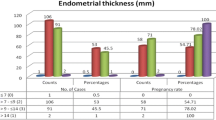Abstract
Purpose: Determine if the evaluation of endometrium one week after embryo transfer can predict pregnancy.
Methods: Endometrial volume and thickness were evaluated by three-dimensional ultrasound in 40 patients one week after embryo transfer. These results were compared to serum pregnancy test performed one week later.
Results: Twenty two patients have achieved pregnancy. A significant difference was found for endometrial volume: 6.49±1.97 mL vs. 3.40±1.11 mL (pregnant vs. not pregnant); and thickness: 11.15±2.75 mm vs. 9.77±1.85 mm. The ROC curve was used to detect the best cutoff values: endometrial volume of 3.48 mL (sensitivity-100%, specificity-68.2%) and endometrial thickness of 10.3 mm (sensitivity-72.2%, specificity-77.3%). The area under curve was significant higher for endometrial volume (0.909 vs. 0.745, P=0.027). No pregnancy was achieved in women who had an endometrial volume <3.8 mL (15 patients) or thickness < 7.9 mm (3 patients).
Conclusions: The endometrial volume and thickness were significant higher in pregnant women and this difference was more prominent for endometrial volume.

Similar content being viewed by others
References
Lambers MJ, van Weering HG, Van't Grunewold MS, Lambalk CB, Homburg R, Schats R, Hompes PG. Optimizing hCG cut-off values: a single determination on day 14 or 15 is sufficient for a reliable prediction of pregnancy outcome.Eur J Obstet Gynecol Reprod Biol 2006 [Epub ahead of print]
Yong P, Martin C, Thong J. A comparison of psychological functioning in women at different stages of in vitro fertilization treatment using the mean affect adjective check list. J Assist Reprod Genet 2000;17:553–6
Keith SC, London SN, Weitzman GA, O'Brien TJ, Miller MM. Serial transvaginal ultrasound scans and beta-human chorionic gonadotropin levels in early singleton and multiple pregnancies. Fertil Steril 1993;59:1007–10
Raine-Fenning NJ, Clewes JS, Kendall NR, Bunkheila AK, Campbell BK, Johnson IR. The interobserver reliability and validity of volume calculation from three-dimensional ultrasound datasets in the in vitro setting. Ultrasound Obstet Gynecol 2003;21:283–91
Yaman C, Jesacher K, Polz W. Accuracy of three-dimensional transvaginal ultrasound in uterus volume measurements; comparison with two-dimensional ultrasound. Ultrasound Med Biol 2003;29:1681–4
Raine-Fenning N, Campbell B, Collier J, Brincat M, Johnson I. The reproducibility of endometrial volume acquisition and measurement with the VOCAL-imaging program. Ultrasound Obstet Gynecol 2002;19:69–75
Raga F, Bonila-Musoles F, Casan EM, Klein O, Bonilla F. Assessment of endometrial volume by three-dimensional ultrasound prior to embryo transfer: clues to endometrial receptivity. Hum Reprod 1999;14:2851–4
Altman DG, Bland JM. Diagnostic tests 3: receiver operating characteristic plots. Br Med J 1994;309:188–90
Dickey RP, Olar TT, Curole DN. Endometrial pattern and thickness associated with pregnancy outcome after assisted reproduction technologies. Hum Reprod 1992;7:418–21
Kovacs P, Matyas S, Boda K, Kaali SG. The effect of endometrial thickness on IVF/ICSI outcome. Hum Reprod 2003;18:2337–41
Friedler S, Schenker JG, Herman A, Lewin A. The role of ultrasound in the evaluation of endometrial receptivity following assisted reproductive treatments: a critical review. Hum Reprod Update 1996;2:323–5
Schild RL, Indefrei D, Eschweiler S, Van Der Ven H, Fimmers R, Hansmann M. Three dimensional endometrial volume calculation and pregnancy rate in an in-vitro fertilization program. Hum Reprod 1999;14:1255–8
Yaman C, Ebner T, Sommergruber M, Polz W, Tews G. Role of three-dimensional ultrasonographic measurement of endometrium volume as a predictor of pregnancy outcome in an IVF-ET program: a preliminary study. Fertil Steril 2000;74:797–801
Ng EH, Chan CC, Tang OS, Yeung WS, Ho PC. Relationship between uterine blood flow and endometrial and subendometrial blood flows during stimulated and natural cycles. Fertil Steril 2006;85:721–7
Jones CJP, Fazleabas AT. Ultrastructure of epithelial plaque formation and stromal cell transformation by post-ovulatory chorionic gonadotrophin treatment in the baboon (Papio anubis). Hum Reprod 2001;16:2680–90
Sengupta J, Ghosh D. Blastocyst-endometrium interaction at the implantation in the rhesus monkey. J Reprod Immunol 2002;3:227–39
Rosario G, Modil ND, Sachdeval G, Manjramkar DD. Morphological events in the primate endometrium in the presence of a preimplantation embryo, detected by the serum preimplantation factor bioassay. Hum Reprod 2005;20:61–71
Facchinetti F, Matteo ML, Artini GP, Volpe A, Genazzani AR. An increased vulnerability to stress is associated with a poor outcome of in vitro fertilization-embryo transfer treatment. Fertil Steril 1997;67:309–14
Smeenk JM, Verhaak CM, Eugster A, van Minnen A, Zielhuis GA, Braat DD. The effect of anxiety and depression on the outcome of in-vitro fertilization. Hum Reprod 2001;16:1420–3
Verhaak CM, Smeenk JM, van Minnen A, Kremer JA, Kraaimaat FW. A longitudinal, prospective study on emotional adjustment before, during and after consecutive fertility treatment cycles. Hum Reprod 2005;20:2253–60
Wu HM, Chiang CH, Huang HY, Chao AS, Wang HS, Soong YK. Detection of the subendometrial vascularization flow index by three-dimensional ultrasound may be useful for predicting the pregnancy rate for patients undergoing in vitro fertilization-embryo transfer. Fertil Steril 2003;79:507–11
Author information
Authors and Affiliations
Corresponding author
Additional information
The endometrial volume and thickness evaluated by three-dimensional ultrasound one week after embryo transfer were significant higher in pregnant women.
Rights and permissions
About this article
Cite this article
Martins, W.d.P., Ferriani, R.A., dos Reis, R.M. et al. Endometrial thickness and volume by three-dimensional ultrasound one week after embryo transfer to detect pregnancy. J Assist Reprod Genet 23, 347–350 (2006). https://doi.org/10.1007/s10815-006-9059-8
Received:
Accepted:
Published:
Issue Date:
DOI: https://doi.org/10.1007/s10815-006-9059-8




